THE CULINARY MARRIAGE RARELY TALKED ABOUT
WHAT IS A BATTIORE DOES WITH HIS HAMMER & THE EMILIA SNACK TO SAMPLE THAT's GOING VIRAL & LAMBRUSCO, REVIVAL, YES REALLY
Offering snacks - croquetas, smoked cod’s roe, stuffed gordal olives, before starters is almost de rigueur in UK restaurants now, often they’re almost the most enticing part of a meal and certainly a good disruptor edging up the spend (and who can blame restaurateurs for needing to do this whilst piquing our appetite?) Yet, they’re missing a trick or two as I learnt in Modena.
Note, Autumn-Winter, is a perfect time to visit Modena. Not least because so many of the buildings are gorgeous hues of Fall, from burnt sienna to terracotta to amber, and, a great many of the streets are protected from the mist and rain under vaulted arcades, and there are a huge number of beguiling traditional cafes and trattorias for warming sustenance. Tortellini in brodo is surely the ultimate, euphoric comfort food, sharing such an exalted position with Jewish chicken soup and Nice’s pistou soup. More on where to eat in Modena in a later substack.
At almost every taverna, trattoria and restaurant we were greeted with morsels of Parmesan Reggiano DOP and balsamico tradizionale DOP. What a way to pique the appetite. Often this intensely savoury snack was accompanied by a joyous plate of golden pillows called Gnocco Fritto which is a dough enriched with lard and, naughtily, fried in, well, more lard. They are served plain or adorned with ricotta, mortadella or prosciutto di Modena and became quite an addition. Much to my amazement, since my return I’ve seen gnocchi fritto on the menu at superb new Wildflowers Restaurant in Chelsea as well as reports of sightings elsewhere!
The Modenese perfected the formula of Emilian snacks or aperitivo, long ago with a platonically perfect blend of umami, acidity, viscosity, and sweet and sour richness. It is old school yet fittingly modern too: parmesan and balsamic vinegar are the Modenese marriage of choice, often offered as an overture to a meal. Though, not all parmesan and balsamic vinegar are created equal and the truly great stuff is, admittedly, precious, high cost and you can’t expect to find it in most trattorias. They will more likely serve basalmico tradizionale DIP rather than DOP, see below to understand the difference.
Yet, when it is a partnership matured slowly over time (as the best relationships are) the experience is blissful of a hunky chunk of parmigiano reggiano DOP aged for 24 months or more, and, the real deal aceto balsamico tradizionale di Modena DOP certified aged a minimum 12 years (which costs £70+ a bottle! ) or Extra Vecchio certified aged a minimum of 25 years (likely to cost more than £100 a bottle). Both are easily recognisable as only one shape bottle is allowed - the inverted tulip shape with a rectangular bottom designed by Giorgetto Giugiaro, whose design career has also seen him create some of Italy’s most iconic cars and Ducati bikes.
The best way to truly understand the mystique surrounding the ultimate balsamic and DOP Parmigiano Reggiano is to see their physically demanding production close up which I had the opportunity to do in Modena late last month.
I was fortunate enough to enjoy and come to deeply appreciate many times during my recent trip Emilia-Romagna hosted by Piacere Moderna.
Piacere Moderna are a superannuated high foodie trade body composed of all the ‘Consortiums’, a most Italian term for those who uphold the traditions and standards of Emilia’s most treasured culinary traditions, continually ratifying the incredibly detailed production chain checks and raising them close to art form.
Dolled up in ultra fetching blue paper hygienic gear, we were given the inside story by the big cheese of Casearia Castelnove, a co-op of farmers producing excellent parmigiano-reggiano that is resolutely artisanal.
Parmigiano Reggiano's history can be traced way back to the Middle Ages. It was first produced in the Po Valley by Cistercian monks as large wheels of cheese that could be easily stored but, above all, might help sustain pilgrims on their long journeys.
Wheels of Parmigiano Reggiano are rated so highly that banks allow Parmigiano producers to use them as guarantees for bank loans to help their cash flow whilst the cheese matures. We really did see the bank surety labels in the parmigiano ageing rooms. Many banks still accept interest payments in parmesan wheels.
It all starts with the terroir and what the cows feed on. It has to be exclusively grass and hay and from cows in the Parmigiano Reggiano production area.
This is strictly limited to the provinces of Parma, Reggio Emilia and Modena and part of Mantua (to the right of the Po River) and Bologna (to the left of the Reno River). (By contrast, Grana Padano can be produced from farms located in 33 provinces between Lombardy, Veneto, Piedmont, Emilia-Romagna and Trentino Alto Adige and allows the use of silage in the feed).
The milk from the evening before and the morning delivered freshly by the farmers is transferred into traditional upturned bell-shaped copper vats. It takes 550 litres of milk to produce each wheel of Parmigiano Reggiano. The milk slowly, and naturally, coagulates with the addition of rennet and a whey starter, from the previous day’s cheese-making.
The curd which forms is then broken down into small granules using a traditional tool called a ‘spino’ rather like a giant whisk. It is cooked at 55 C and the cheesy granules sink to the bottom of the vat and form a single mass.
Cut into two parts and wrapped in the typical linen cloth, the cheese is then placed in a mould which gives the cheese its final shape. The cheeses are given their identity card in the form of a casein plate with a unique code making it possible to trace its origins and time of production. The wheels are then immersed in a salted solution.
The minimum maturation period for Parmigiano Reggiano is 12 months and, although the average maturation period is 24 months, the cheese can be matured for much longer – even up to 30 months and beyond. Whereas Grana Padano is marked at 9 months and on average consumed at 15 months and quality checks are random.
It is the battitore who checks every single wheel of Parmigiano Reggiano DOP tappling with a special little hammer than divine any internal cracks or hollows from its sound, which would prevent it maturing properly and becoming more incredible and complex over time.
Unsurprisingly. cattle breed also affects the quality and taste of the parmesan, too. Pezzata Rossa, from red cows has a distinctive reddish brown rind and rich spice and dried fruit taste that is quite different from the more moist and crumbly pale ivory parmigiano we tasted.
The best parmesan I've ever tasted is made from the milk of Vacca Bianca Modenese, white cows, which graze in idyllic high-altitude pastures of herbs and grasses. There is only one farm making it at their Caseificio Rosola. This parmigiano is incredibly savoury, and piquant yet delicate. The production is so modest and demand so strong among local connoisseurs that it is only sold direct from the farm or online at https://caseficiorosola.it. The best way to try it is on Bottura's astonishing signature dish, Five ages and Temperatures of Parmigiano Reggiano which is also served at the Francescana restaurant offering a tasting menu of nine of his classic dishes from 3 Michelin star Osteria Francescana at Casa Maria Luigia.
Even this rarified parmigiano is lifted further with a dribble of balsamic tradizionale which is a whole different ingredient to the condiment found in supermarkets and surely a ‘foodie bucket list’ taste to experience.
Curiously balsamico tradizionale has only been recognised since 1967 to be precise, before it was only really produced privately within families, especially among the aristocracy who bequeathed their balsamic in wills and it formed a valuable part of dowries (and often still is). It is likely that a kind of balsamico or grape must that had special properties and tended to ferment and turn to vinegar was revered by the Ancient Romans. It was mentioned by Pliny, Cicero and Virgil.
Trebbiano or Lambrusco grapes (more on resurgence of a completely different quality of Lambrusco anon) are most often used. Some families and restaurants have a small vineyard purely to provide grapes to press for grape must to make their balsamic.
Genuine balsamic vinegar is made purely from crushed, unfermented grape juice and heated in open vats for about 24 hours, slowly reduced to make it more viscous. About 100 kilograms of grapes are used to produce about 75 litres of liquid. After the heating process, only 35 litres remain. The reduced liquid is placed into a series of a minimum of five barrels called a batteria. Over time, it is aged in a succession of wooden barrels including oak, chestnut, mulberry, cherry, acacia and juniper, and transferred from one barrel to another, from the largest to the smallest. The increasingly smaller amounts are due to the evaporation that occurs.
Unlike wine, balsamico needs to oxidise which makes the balsamic more dense and sweeter. It takes on notes of vanilla, cinnamon and clove as the liquid ages and evaporates. After a minimum of 12 years + of maturing, balsamic tradizionale DOP will be a dark, sweet-sour, velvety elixir with complex flavour and a resinous tang. It is expensive around £75-80 over £100 for the optimal 25 year + balsamic which is an incredible velvety, viscous nectar resonant with cherry and woody flavours to be enjoyed sparingly. Balsamico Tradizionale IGP is aged for a maximum of three years and will have wine vinegar added to the grape must. Some producers will confusingly adorn their bottles with promises of ‘invecchiato’ that is, aged, and faux grand labels yet it is not pure grape must, most enjoyable though it is in a salad dressing or as a cooking ingredient where the acidity is welcome. It may cost around £18.00. Balsamic condiment will be a mix of Balsamico Tradizionale with added cooked wine must and probably some added flavour, perhaps caramel too for colour (it’s a case of check the label!). Giusto, who have been in business since 1605, do make a beautiful, ruby, plummy truffle condiment with added extract of black truffle which should cost around £12. Their shop in Modena is exquisite and they sell all ages and qualities up to the stratospheric and are generous with tastings. Sous Chef sell some of their range in the UK.
When it comes to taste-testing balsamico, ideally treat it like caviar: pour a few drops on the back of your hand between the thumb and forefinger: where the warmth of your skin will heighten the flavours.
I didn’t need much converting
The best accompaniment? Contain your shock…lambrusco!!
It has a badly tarnished reputation from the 1970s However, a few clever winemakers are changing that using the same tank fermentation process used in prosecco. Modern lambrusco is dry with a firm acidity that keeps it fresh on the palate and a gentle fizz
Lambrusco Grasparossa di Castelvetro is a deep ruby red with violet hues and has plenty of blackcurrant, plum and raspberry fruit with notes of spice Try Lambrusco Pruno Nero Dry from Waitrose. Try too, Chiarli Vecchia Modena Sparkling Pignoletto at Waitrose.
EXPERIENCE A BALSAMIC ACETAIA
Osteria di Rubbiara https://www.acetaiapedroni.it/en/tavern-rubbiara
An utterly charming, traditional tavern, in the same family for six traditions, now run by Giuseppe. It’s all mahogany, linen and lace and vintage photos on the walls, there’s no menu and guests must leave their mobiles in the boxes provided as the emphasis is on old-fashioned conviviality. Lunch typically includes gnocchi fritto with prosciutto, a fabulous omelette with onion, garlic, rosemary, pumpkin tortellini with balsamico, and vanilla ice-cream with a drizzle of the precious balsamico tradizionale DOP vecchio aged 25 years or more.
Guests are welcome to visit the acetaia (and shop) of the revered Pedroni balsamico in the former stables of the tavern.
Osteria di Rubbiara is about 10 km from central Modena and there’s a bus from the city centre or shared/individual taxis.
Casa Maria Luigia https://casamarialuigi.it
There’s an acetaia at Massimo and Lara Bottura’s Casa Maria Luigia, a totally idyllic and highly quirky and sophisticated small guest house, whose head chef Jess Rosval has just this week won her first Michelin red star and green star for Al Gatto Verde, where she serves fire cooking like no other, playful, creative and elegant. There’s also a restaurant Francescana at Casa Maria Luigia where a nine course meal of Massimo’s greatest hits are served with storytelling at communal tables. His celebrated Five Ways with Parmesan dish is one of the favourite courses. Guests enjoy a stupendous brunch based on the Christmas breakfasts Massimo remembers his Nonna preparing.
Two years ago Casa Maria Luigia (which opened in 2019) acquired the neighbouring property’s acetaia founded in 1969. With it came more than 1200 barrels, some dating back to the 1900s, that now produce their exceptional balsamico. It wouldn’t be a Massimo experience without great art even in the balsamic cellar. There’s an exquisite blistered glass table scape sculpture by Joan Cruz and an exuberant ‘heart attack’ light by Ingo Mauer. All guests staying can have a private tour of the Acetaia. Otherwise, groups and individuals are welcome by reservation.
Casa Maria Luigia is about 7km from Modena and accessible by taxi.




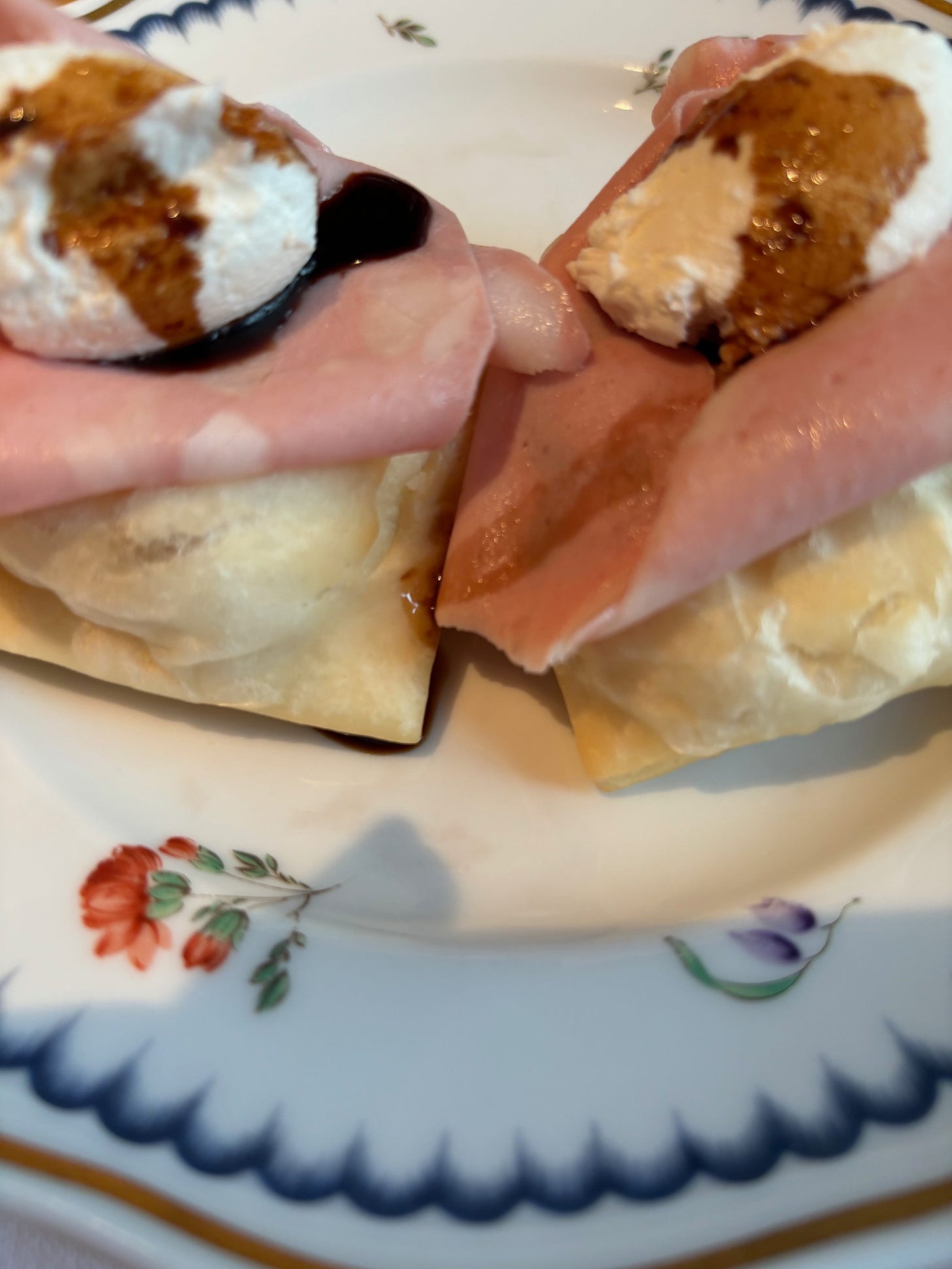
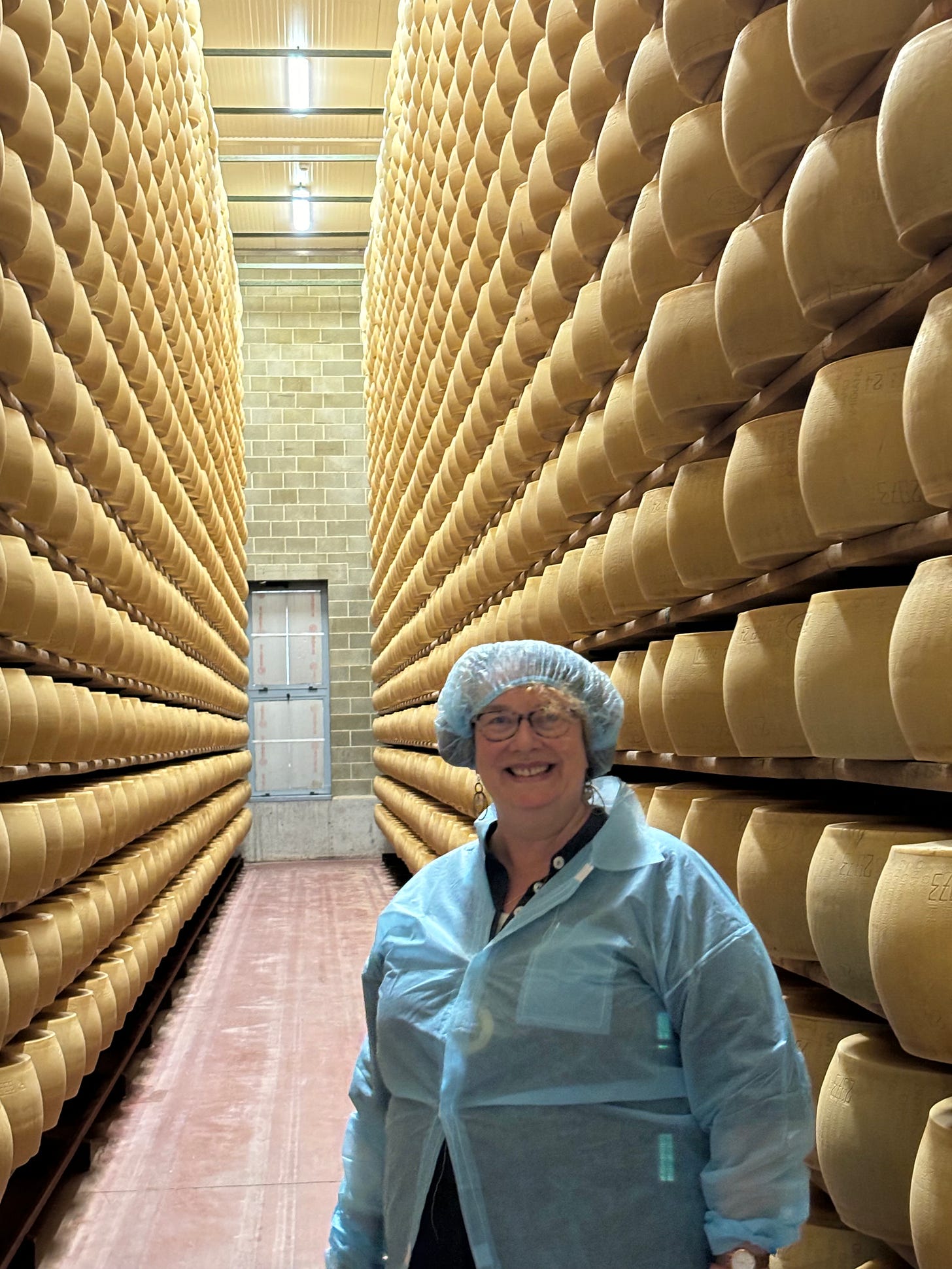






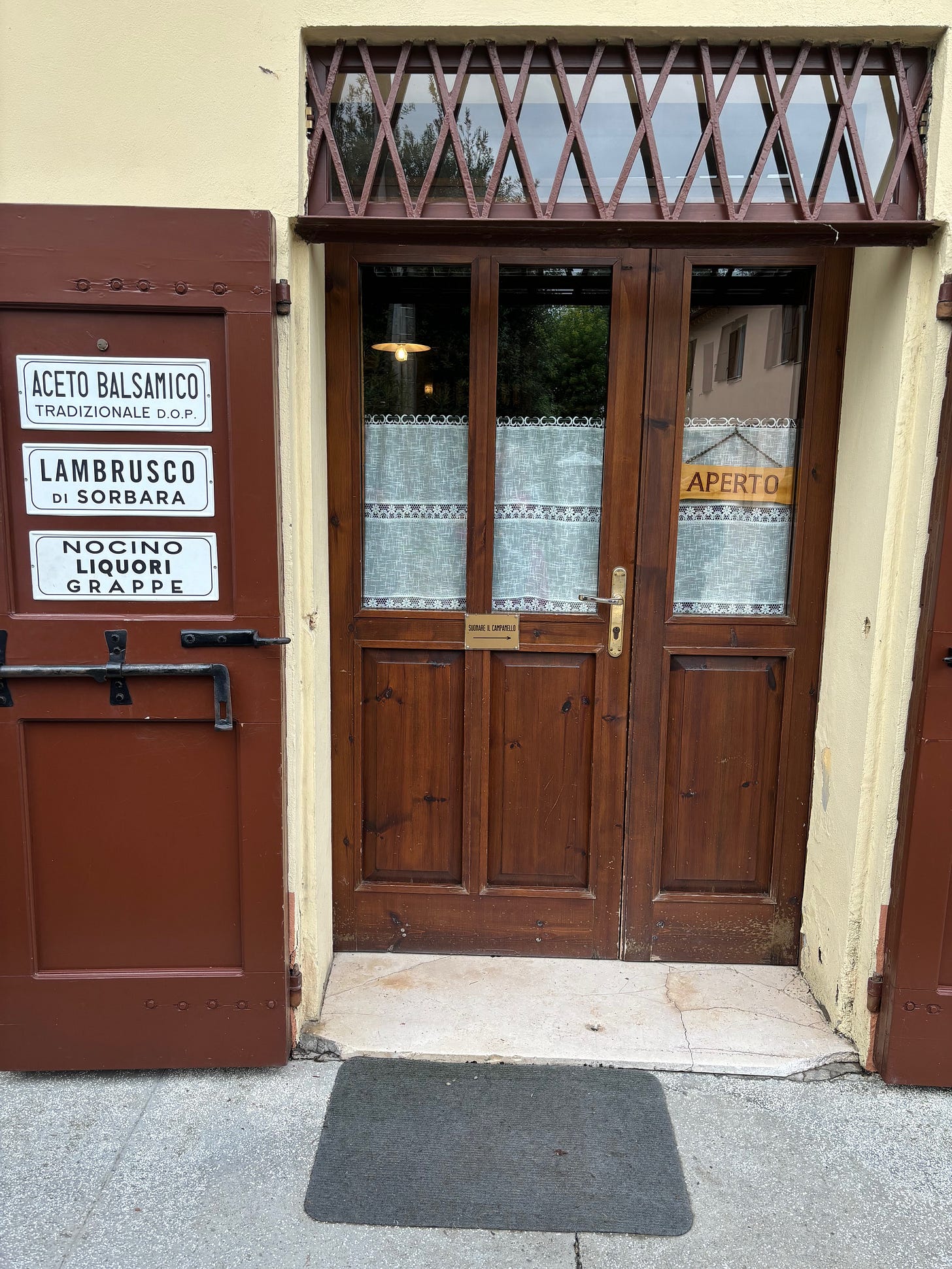
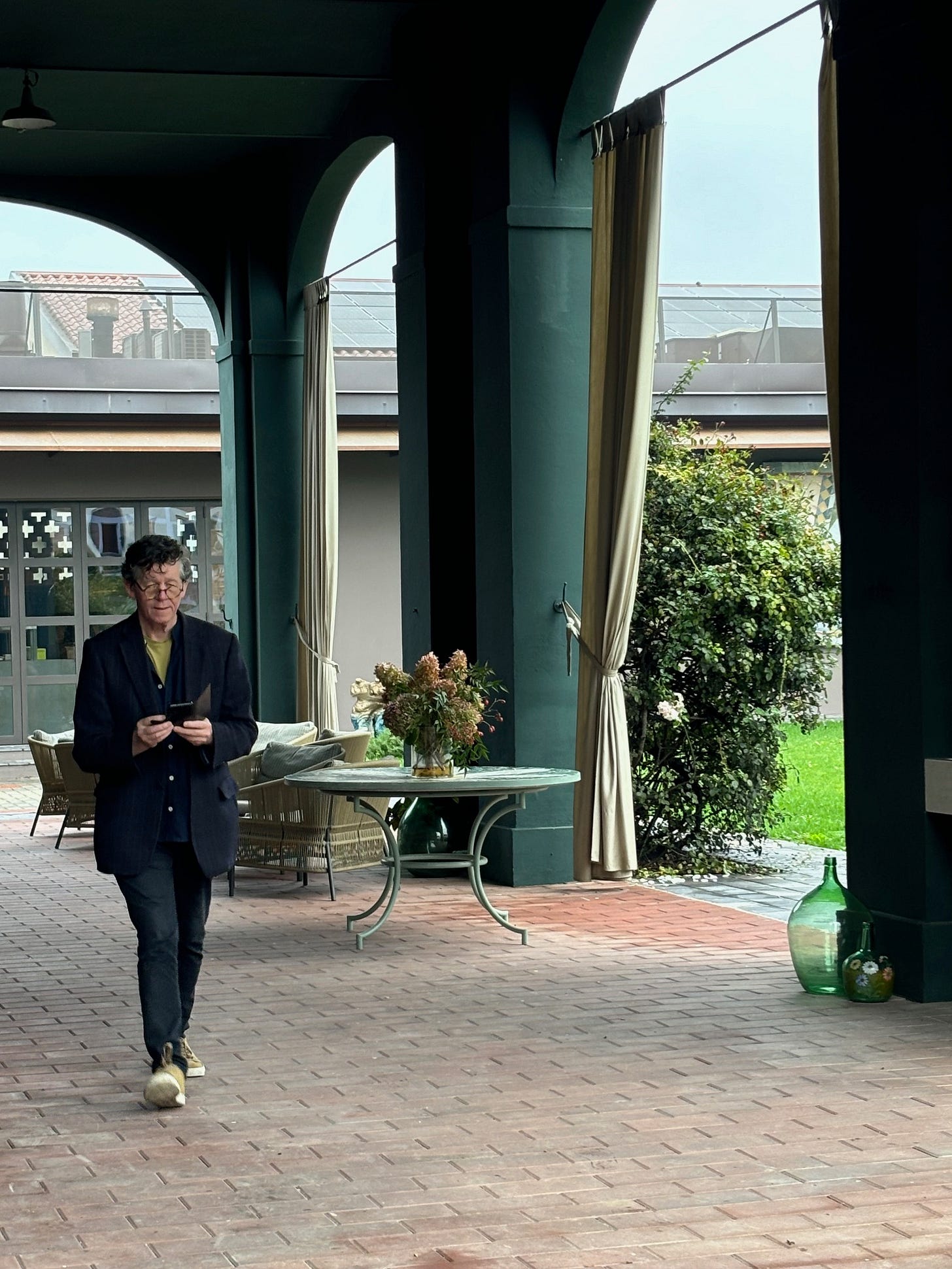

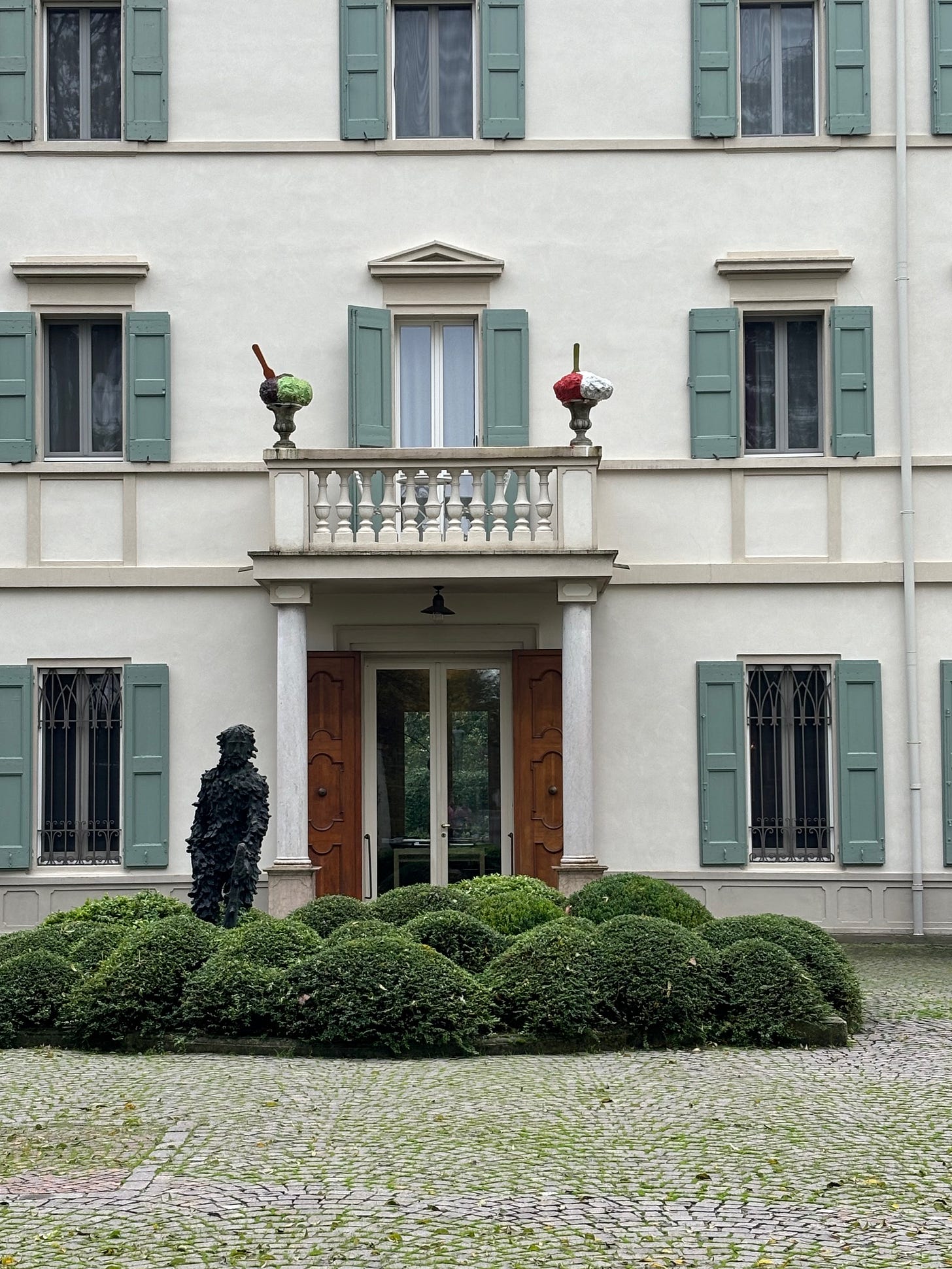
Such beautiful writing, Sudi! I felt completely transported to Modena. Reading about the Parmesan and balsamic, and the respect for the craft behind them, makes me want to visit right away. Absolutely wonderful piece!
I so enjoyed reading this Sudi! It brought back very happy memories of my trip to Modena and Casa Maria Luigia.....my mouth salivates thinking about the crumbly morsels of Parmigiano and the thick drops of Balsamic Vinegar.....as a lover of Mortadella, my vices were well and truly catered for there!